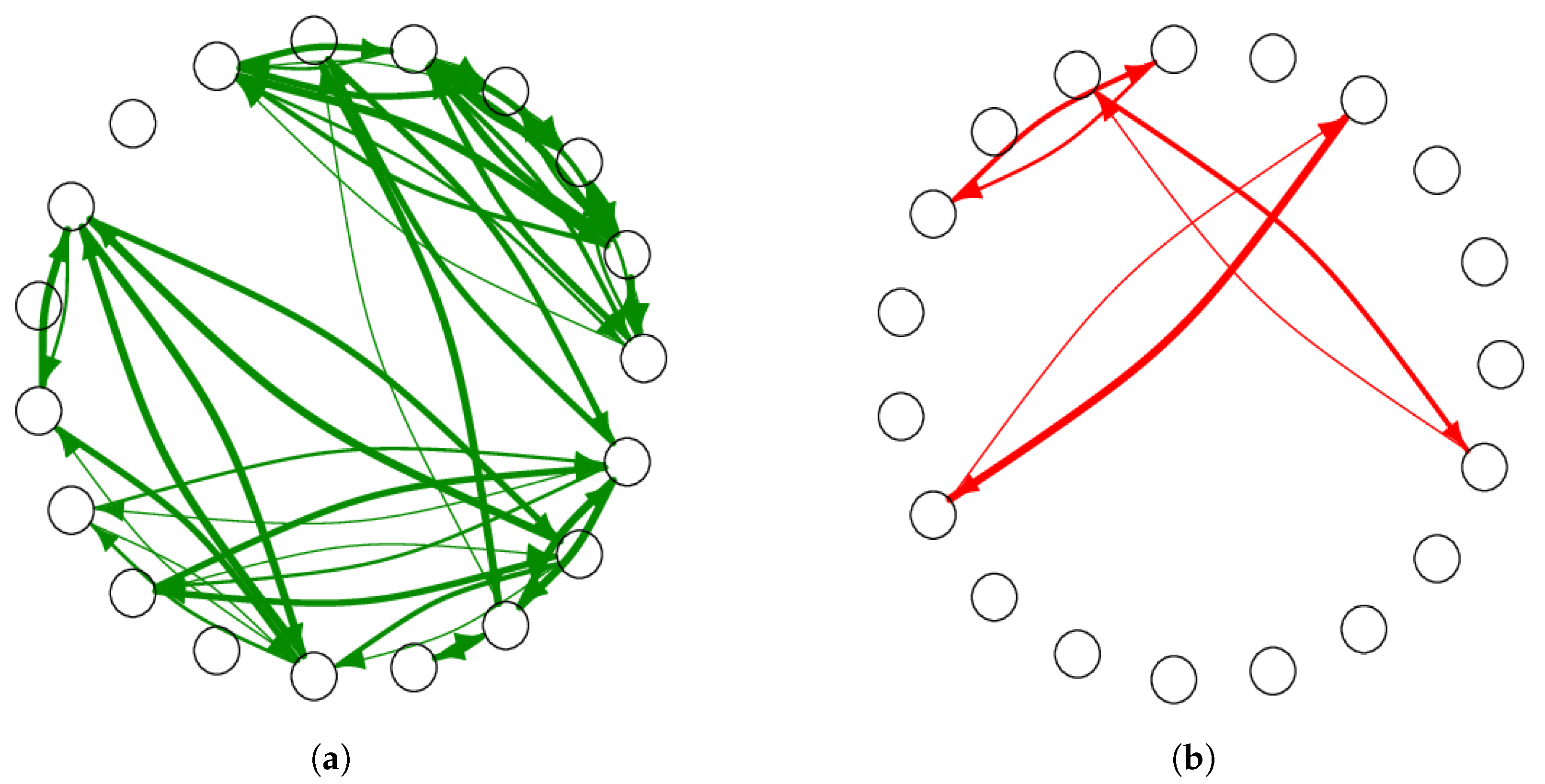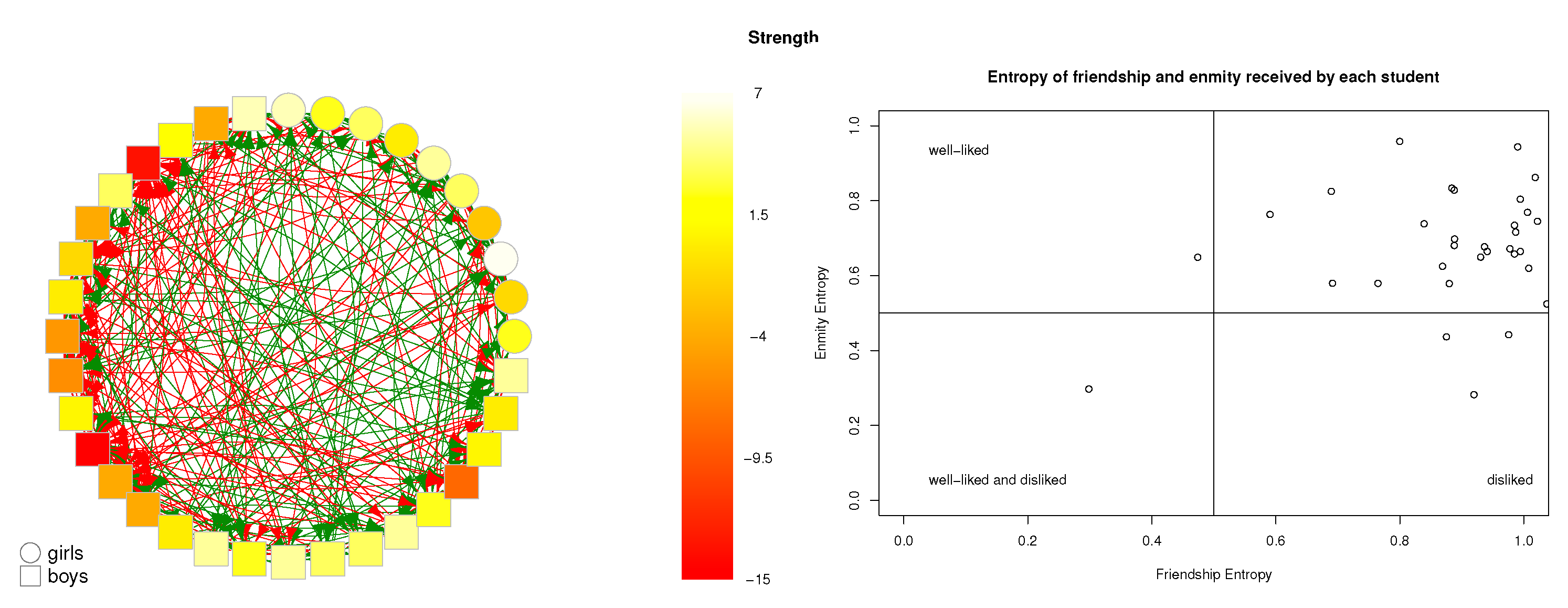Popularity and Entropy in Friendship and Enmity Networks in Classrooms
Abstract
:1. Introduction
2. Materials and Methods
2.1. Popularity and Reciprocity
2.2. Structural Entropy
3. Results
3.1. Subnetworks
3.2. Entropy in Friendship and Enmity Networks
4. Conclusions
Author Contributions
Funding
Institutional Review Board Statement
Informed Consent Statement
Data Availability Statement
Conflicts of Interest
References
- Laursen, B.P. Close Friendships in Adolescence; Jossey-Bass, Inc.: San Francisco, CA, USA, 1993. [Google Scholar]
- Hartup, W.W. The Three Faces of Friendship. J. Soc. Pers. Relationsh. 1995, 12, 569–574. [Google Scholar] [CrossRef]
- Bukowski, W.M.; Sippola, L.K. Friendship and development: Putting the most human relationship in its place. New Dir. Child Adolesc. Dev. 2005, 109, 91. [Google Scholar] [CrossRef]
- Vitaro, F.; Boivin, M.; Bukowski, W.M. The role of friendship in child and adolescent psychosocial development. In Handbook of Peer Interactions, Relationships, and Groups; Rubin, K.H., Bukowski, W.M., Laursen, B., Eds.; The Guilford Press: New York, NY, USA, 2009; pp. 568–585. [Google Scholar]
- Jiao, C.; Wang, T.; Liu, J.; Wu, H.; Cui, F.; Peng, X. Using Exponential Random Graph Models to Analyze the Character of Peer Relationship Networks and Their Effects on the Subjective Well-being of Adolescents. Front. Psychol. 2017, 8, 583. [Google Scholar] [CrossRef] [Green Version]
- Block, P.; Grund, T. Multidimensional homophily in friendship networks. Netw. Sci. 2014, 2, 189. [Google Scholar] [CrossRef] [PubMed] [Green Version]
- Kandel, D.B. Homophily, selection, and socialization in adolescent friendships. Am. J. Sociol. 1978, 84, 427–436. [Google Scholar] [CrossRef]
- Selfhout, M.; Burk, W.; Branje, S.; Denissen, J.; Van Aken, M.; Meeus, W. Emerging late adolescent friendship networks and Big Five personality traits: A social network approach. J. Personal. 2010, 78, 509–538. [Google Scholar] [CrossRef] [Green Version]
- Fowler, J.H.; Settle, J.E.; Christakis, N.A. Correlated genotypes in friendship networks. Proc. Natl. Acad. Sci. USA 2011, 108, 1993–1997. [Google Scholar] [CrossRef] [Green Version]
- Rapoport, A.; Horvath, W.J. A study of large sociogram. Behav. Sci. 1961, 6, 279–291. [Google Scholar] [CrossRef]
- Ball, B.; Newman, M. Friendship networks and social status. Netw. Sci. 2013, 1, 16–30. [Google Scholar] [CrossRef] [Green Version]
- Huerta-Quintanilla, R.; Canto-Lugo, E.; Viga-de Alva, D. Modeling social network topologies in elementary schools. PLoS ONE 2013, 8, e55371. [Google Scholar] [CrossRef]
- Wittek, M.; Kroneberg, C.; Lämmermann, K. Who is fighting with whom? How ethnic origin shapes friendship, dislike, and physical violence relations in German secondary schools. Soc. Netw. 2020, 60, 34–47. [Google Scholar] [CrossRef]
- van der Ploeg, R.; Steglich, C.; Veenstra, R. The way bullying works: How new ties facilitate the mutual reinforcement of status and bullying in elementary schools. Soc. Netw. 2020, 60, 71–82. [Google Scholar] [CrossRef]
- Harrigan, N.; Labianca, G.; Agneessens, F. Negative ties and signed graphs research: Stimulating research on dissociative forces in social networks. Soc. Netw. 2020, 60, 1–10. [Google Scholar] [CrossRef]
- García-Rodríguez, A.; Govezensky, T.; Gershenson, C.; Naumis, G.G.; Barrio, R.A. Extracting real social interactions from social media: A debate of COVID-19 policies in Mexico. arXiv 2021, arXiv:2106.09068. [Google Scholar] [CrossRef]
- Weron, T.; Szwabiński, J. Opinion Evolution in Divided Community. Entropy 2022, 24, 185. [Google Scholar] [CrossRef] [PubMed]
- de la Haye, K.; Dijkstra, J.K.; Lubbers, M.J.; van Rijsewijk, L.; Stolk, R. The dual role of friendship and antipathy relations in the marginalization of overweight children in their peer networks: The TRAILS Study. PLoS ONE 2017, 12, e0178130. [Google Scholar] [CrossRef] [Green Version]
- McCabe, J.M. Connecting in College: How Friendship Networks Matter for Academic and Social Success; University of Chicago Press: Chicago, IL, USA, 2016. [Google Scholar]
- Hernández-Hernández, A.M.; Viga-de Alva, D.; Huerta-Quintanilla, R.; Canto-Lugo, E.; Laviada-Molina, H.; Molina-Segui, F. Friendship Concept and Community Network Structure among Elementary School and University Students. PLoS ONE 2016, 11, e0164886. [Google Scholar] [CrossRef] [Green Version]
- Duarte-Barahona, R.; Arceo-May, E.; Huerta-Quintanilla, R. Friendship Formation in the Classroom Among Elementary School Students. In Complex Networks and Their Applications VIII; Cherifi, H., Gaito, S., Mendes, J.F., Moro, E., Rocha, L.M., Eds.; Springer: Cham, Switzerland, 2020; pp. 403–414. [Google Scholar]
- Krawczyk, M.J.; del Castillo-Mussot, M.; Hernández-Ramírez, E.; Naumis, G.G.; Kułakowski, K. Heider balance, asymmetric ties, and gender segregation. Phys. A Stat. Mech. Its Appl. 2015, 439, 66–74. [Google Scholar] [CrossRef] [Green Version]
- Mantzaris, A.V.; Domenikos, G.R. Exploring the entropic nature of political polarization through its formulation as a isolated thermodynamic system. Sci. Rep. 2023, 13, 4419. [Google Scholar] [CrossRef]
- Hellman, Z.; Peretz, R. A survey on entropy and economic behaviour. Entropy 2020, 22, 157. [Google Scholar] [CrossRef] [Green Version]
- Anand, K.; Bianconi, G. Entropy measures for networks: Toward an information theory of complex topologies. Phys. Rev. E 2009, 80, 045102. [Google Scholar] [CrossRef] [Green Version]
- Dehmer, M.; Mowshowitz, A. A history of graph entropy measures. Inf. Sci. 2011, 181, 57–78. [Google Scholar] [CrossRef]
- Li, S.; He, J.; Song, K. Network entropies of the Chinese financial market. Entropy 2016, 18, 331. [Google Scholar] [CrossRef] [Green Version]
- Spyropoulos, A.Z.; Bratsas, C.; Makris, G.C.; Ioannidis, E.; Tsiantos, V.; Antoniou, I. Entropy and network centralities as intelligent tools for the investigation of terrorist organizations. Entropy 2021, 23, 1334. [Google Scholar] [CrossRef] [PubMed]
- Zhang, J.; Zhang, Q.; Wu, L.; Zhang, J. Identifying Influential Nodes in Complex Networks Based on Multiple Local Attributes and Information Entropy. Entropy 2022, 24, 293. [Google Scholar] [CrossRef] [PubMed]
- Eagle, N.; Macy, M.; Claxton, R. Network diversity and economic development. Science 2010, 328, 1029–1031. [Google Scholar] [CrossRef] [PubMed]
- Borner, K.; asta, L.D.; Ke, W.; Vespignani, A. Studying the emerging global brain: Analyzing and visualizing the impact of co-authorship teams. Complexity 2005, 10, 57–67. [Google Scholar] [CrossRef] [Green Version]
- Chen, Z.; Dehmer, M.; Emmert-Streib, F.; Shi, Y. Entropy of weighted graphs with Randić weights. Entropy 2015, 17, 3710–3723. [Google Scholar] [CrossRef] [Green Version]
- Vasishth, S.; Broe, M. The Foundations of Statistics: A Simulation-Based Approach; Springer Science & Business Media: Berlin, Germany, 2010. [Google Scholar]
- R Core Team. R: A Language and Environment for Statistical Computing; R Foundation for Statistical Computing: Vienna, Austria, 2023. [Google Scholar]





| Popularity | |||
|---|---|---|---|
| Unpopular | Average | Popular | |
| Mean | Mean | Mean | |
| Only Friendship | |||
| Received Friendship | 1.27 | 3.68 | 6.25 |
| Given Friendship | 3.17 | 3.99 | 4.17 |
| Opposite-sex friendship | 1.17 | 1.33 | 1.43 |
| Only Enmity | |||
| Received Enmity | 4.51 | 3.04 | 1.78 |
| Given Enmity | 2.46 | 3.12 | 3.26 |
| Opposite-sex Enmity | 1.15 | 1.47 | 1.59 |
| Reciprocity | |||
| Friendship | 0.21 | 0.52 | 0.70 |
| Enmity | 0.39 | 0.32 | 0.22 |
| Opposite-sex friendship | 0.05 | 0.20 | 0.28 |
| Popularity in Reciprocal Friendship | |||
| Unpopular | 0.10 | 0.17 | 0.17 |
| Average | 0.34 | 1.03 | 1.62 |
| Popular | 0.21 | 0.89 | 1.15 |
| Popularity in Reciprocal Enmity | |||
| Unpopular | 0.22 | 0.25 | 0.18 |
| Average | 0.52 | 0.47 | 0.43 |
| Popular | 0.21 | 0.25 | 0.11 |
| Gender | ||
|---|---|---|
| Female | Male | |
| Mean | Mean | |
| Only Friendship | ||
| Recieved Friendship | 3.64 | 4.15 |
| Given Friendship | 3.75 | 4.00 |
| Opposite-sex Friendship | 1.24 | 1.44 |
| Only Enmity | ||
| Recieved Enmity | 2.87 | 3.20 |
| Given Enmity | 2.94 | 3.12 |
| Opposite-sex Enmity | 1.30 | 1.59 |
| Reciprocity | ||
| Friendship | 0.53 | 0.51 |
| Opposite-sex Friendship | 0.44 | 0.49 |
| Enmity | 0.29 | 0.29 |
| Popularity in Reciprocal Friendship | ||
| Impopular | 0.16 | 0.15 |
| Average | 1.06 | 1.02 |
| Popular | 0.76 | 0.88 |
| Popularity in Reciprocal Enmity | ||
| Impopular | 0.23 | 0.21 |
| Average | 0.50 | 0.44 |
| Popular | 0.21 | 0.19 |
| Range Age | |||
|---|---|---|---|
| 9–15 | 15–20 | 20- | |
| M | M | M | |
| Only Friendship | |||
| Recived Friendship | 4.51 | 3.76 | 3.48 |
| Given Friendship | 4.45 | 3.76 | 3.46 |
| Opposite-sex Friendship | 0.95 | 1.38 | 1.65 |
| Only Enmity | |||
| Recived Enmity | 3.85 | 2.94 | 2.72 |
| Given Enmity | 4.0 | 2.94 | 2.76 |
| Opposite-sex Enmity | 2.27 | 1.35 | 1.20 |
| Reciprocity | |||
| Friendship | 0.51 | 0.58 | 0.51 |
| Enmity | 0.24 | 0.35 | 0.34 |
| Opposite-sex Friendship | 0.33 | 0.55 | 0.49 |
Disclaimer/Publisher’s Note: The statements, opinions and data contained in all publications are solely those of the individual author(s) and contributor(s) and not of MDPI and/or the editor(s). MDPI and/or the editor(s) disclaim responsibility for any injury to people or property resulting from any ideas, methods, instructions or products referred to in the content. |
© 2023 by the authors. Licensee MDPI, Basel, Switzerland. This article is an open access article distributed under the terms and conditions of the Creative Commons Attribution (CC BY) license (https://creativecommons.org/licenses/by/4.0/).
Share and Cite
Sánchez-Espinosa, D.B.; Hernández-Ramírez, E.; del Castillo-Mussot, M. Popularity and Entropy in Friendship and Enmity Networks in Classrooms. Entropy 2023, 25, 971. https://doi.org/10.3390/e25070971
Sánchez-Espinosa DB, Hernández-Ramírez E, del Castillo-Mussot M. Popularity and Entropy in Friendship and Enmity Networks in Classrooms. Entropy. 2023; 25(7):971. https://doi.org/10.3390/e25070971
Chicago/Turabian StyleSánchez-Espinosa, Diego B., Eric Hernández-Ramírez, and Marcelo del Castillo-Mussot. 2023. "Popularity and Entropy in Friendship and Enmity Networks in Classrooms" Entropy 25, no. 7: 971. https://doi.org/10.3390/e25070971
APA StyleSánchez-Espinosa, D. B., Hernández-Ramírez, E., & del Castillo-Mussot, M. (2023). Popularity and Entropy in Friendship and Enmity Networks in Classrooms. Entropy, 25(7), 971. https://doi.org/10.3390/e25070971





